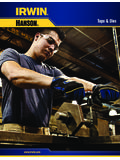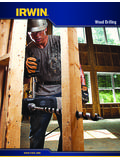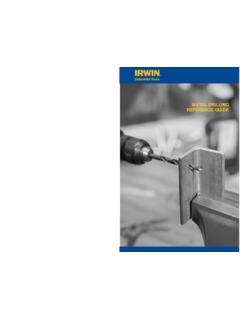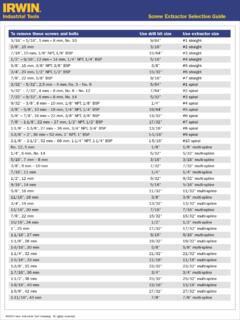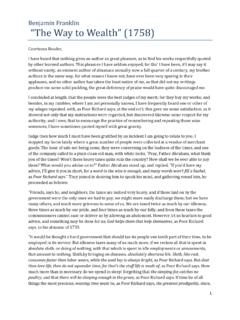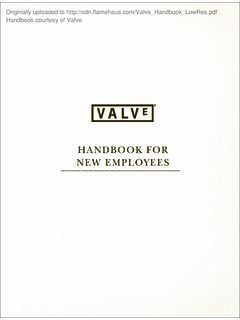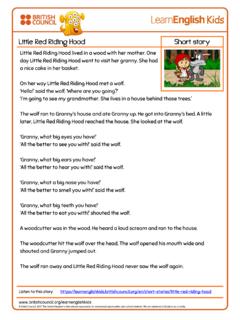Transcription of IRWIN Rafter Square Reference Guide
1 IRWIN Rafter Square can also be used as a Protractor, Saw Guide , and Tri & Miter SquareL querre de charpente IRWIN peut galement tre utilis e comme rapporteur d angle, Guide de scie et querre paulement et ongletLa escuadra IRWIN para vigas tambi n se puede emplear como protractor, gu a de sierra y como tri-escuadra de Rafter Square Reference Guide Complete Instruction Book and Rafter Length 20118935 NorthPointe Executive DriveHuntersville, NC 28078 - a de referencia IRWIN para escuadras de vigaManual de instrucciones completo y tabla de longitud de vigasGuide de r f rence pour l querre de charpente IRWIN Manuel d instructions complet et tableaux des longueurs de chevrons1 IRWIN Rafter Square Reference GuIdeProfessional tradesmen use Rafter and Framing Squares to save time on roof construction projects.
2 All of the necessary cuts for a particular Rafter can be laid out with these two squares. This Reference Guide will provide a basic knowledge of rafters and the Rafter Square to help you determine what scale and number on the Square to use, as well as all necessary tables for SDiagrams of Rafter and Framing Squares ..2 Types of Rafters ..3 Using the Rafter Common Rafter and Valley Rafters ..13 Hip Rafter Layout ..15 Valley Rafter Layout ..17 Jack Jack Rafter Layout ..21 Dormer Length Of Rafter Square [diagram 1 IRWIN Rafter Square ]111234567810121513243023024181512 1087654323456 SEAT CUTSH I P - VAL TO P CUTSCO M M O N TO P CUTS5101520253035404550556065707580D EGMARK ALONGTHIS EDGEINCH SCALERAFTER SEAT NOTCH CUTHIP AND VALLEYRAFTER SCALE( TOP CUTS )COMMON RAFTERSCALE ( TOP CUTS )PROTRACTOR/DEGREE SCALEFOOTINCH SCALESCRIBINGSLOTS( SPACED )3tYPeS Of RafteRScommon Rafter : A Rafter that runs perpendicular (90 ) from the top of the wall plate to the roof ridge.
3 Its length forms the hypotenuse or diagonal of a right (90 ) triangle, with the rise and run forming the right angleValley Rafter : A Rafter that runs from the top of the wall plate to the roof ridge at the intersection of the gable extension with the main roofValley Jack Rafter : A Rafter that runs from a valley Rafter to the roof ridge, perpendicular to the ridgeHip Rafter : A Rafter that runs diagonally from the top of the wall plate to the roof ridge, forming the outside corner of the roofHip Jack Rafter : A Rafter that runs from the top of the wall plate to the hip Rafter , perpendicular to the wall platecripple Jack Rafter : A Rafter that runs from a hip Rafter to a valley Rafter , perpendicular to the roof ridgedormer Rafter : A Rafter that sits on top of the main roof without cutting into the main roof.
4 (For example, this Rafter would be used when remodeling or adding on to an existing structure.) Figures 1 and 2 on the next page show each type of RAFTERVALLEY RAFTERVALLEY JACKDORMERA (DormerRafterSection)B (DormerRafterSection)All cuts on this roof can be made by using the appropriate inch rise number on the Rafter 1: Types of Rafters - 3D[fig. 1 types of Rafters 3d]5[fig. 2 types of Rafters top View]COMMONDORMERRIDGEHIPJACKSHIPPL ATEVALLEYJACKSCRIPPLEJACKVALLEYFIGURE 2: Types of Rafters - Top View6uSING tHe Rafter SquaReThe use of the Rafter Square is based on two simple building measurements: (1) the Rafter run and (2) the Rafter rise.
5 These can be obtained from building blueprints, drawings, or actual measurements. The tables included in this Reference Guide are based on these two simple measurements. (See figure 3.) Rafter Run: The horizontal distance that the Rafter will span, measured in feetRafter Rise: The vertical distance between the highest and lowest point of the Rafter , measured in feetInch Rise: The rise measured in inches per foot runThe Inch Rise gives you the corresponding scale number to use on the Square and is calculated as follows. Inch Rise, run, and the tables in the back of this Guide are all that you need to layout Rafter lengths and cuts for common, hip, valley, and jack BRUN AFOR EVEN PITCHEDROOFS RUN A = RUN BRAFTER ARAFTER BRAFTER ARAFTER BRUN BRUN ARUN ARUN BRISE ARISE CRUN CRISE BRAFTER BRAFTER ARAFTER CRISERUN RAFTERFIGURE 3: Rafter Rise and Run[fig.]
6 3 Rafter Rise and Run]7 The procedure for basic roof construction is as follows (See figure 4.):1. Obtain Rafter Run: Measure or calculate the horizontal distance the Rafter will span, starting at the outside of the wall on which it rests and including any boarding on the wall if it extends to the wall top plate. 2. Obtain Roof Rise: Measure, calculate, or obtain from the blueprints the distance in feet the ridge will be from the top of the wall. Use the following table to convert inches to feet:convert Inches to feet1" =.
7 08' 4" = .33' 7" = .58' 10" = .83' 2" = .16' 5" = .42' 8" = .67' 11" = .92' 3" = .25' 6" = .50' 9" = .75'3. calculate Inch Rise: Using the table above, convert rise to feet in decimal form and calculate using the Inch Rise : Run = 15'; Rise = 8'8" or ' in/ft. (ft) x 1215 (ft)=You may round off Inch Rise to the nearest inch, which can make the actual roof rise slightly higher or lower but will not matter in most cases. If the Inch Rise is provided on a blueprint, the previous calculation is not needed. With the Inch Rise calculated, we are now ready to layout each type of RISE(SCALE NUMBER) Rafter RISE (ft) x 12 Rafter RUN (ft)=8 TAI LOREAVERAFTER LENGTHSEAT NOTCHSET ON TOPPL ATERUNRISETAIL RUNPLUMB CUTAWITHOUT RIDGERAFTER LENGTHRUNRISETAIL RUNTAI LOREAVE90 BWITH RIDGEINCH RISE PERFOOT RUNRISE x 12 RUN= Rafter LENGTHRUN2 + RISE2(FIND IN TABLES)=PLUMB CUTFIGURE 4: Common Rafter [fig.]
8 4 the common Rafters]9cOMMON RafteRS common Rafter Length: Once Inch Rise and Run are calculated, use the tables in the back of this book to find common Rafter length. NOTE: For a run greater than that given in the tables, add any two runs that will equal the desired run, then find the respective lengths for those two rafters and add them : Using the 7 Inch Rise table (and our 15' run), the common Rafter length is 17' 43 8". This is the Rafter length from the top cut to the seat plumb or eave Length: The tail or eave overhang must be added to the Rafter length.
9 (See figure 5 for various eave constructions.)EXAMPLE: With a tail run of 1' 8", use the same 7 Inch Rise table, under Common Rafter Length: 1' Run = 1' 17 8" 8" Run = 91 4" 1' 8" Tail = 1' 111 8"common Rafter Lumber Length: To obtain the total lumber length required, an allowance for the bottom plumb cut must be added. (See figure 6.) This allowance can be obtained by using the tables as well. EXAMPLE: Using the 7 Inch Rise page and assuming 2 x 6 lumber (which has a depth of 51 2"), use the Rafter Depth and Bottom Allowance table to see that the common and jack allowance equals 33 16" inches.
10 The total lumber length required for this common Rafter is: Rafter LENGTH = 17' 43 8" TAIL LENGTH = 1' 111 8" BOTTOM ALLOWANCE = 33 16"TOTAL LUMBER LENGTH = 19' 611 16"10 When a wider eave is wanted, 2 or greater, some type of supportwill be needed. To support center of plywood soffit, nail up thru plywood into this type of eavewhen there is very little plate using a 2 x for a flat pitch roofwith 4 inch rise or 5: Eave Constructionscommon Rafter Layout1. top Plumb cut: If the lumber is not straight, always put the high or crown side up.
